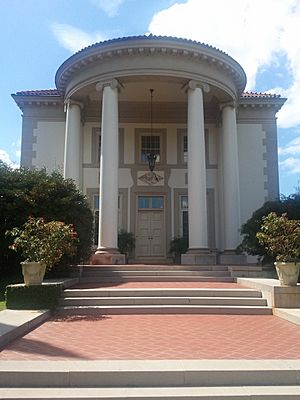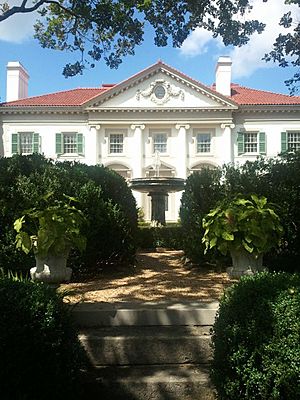Hills and Dales Estate facts for kids
Hills and Dales Estate is a grand home built for a successful businessman named Fuller Earle Callaway and his wife, Ida Cason Callaway. It was finished in 1916 in LaGrange, Georgia. The property also includes the amazing Ferrell Gardens, which were started way back in 1832 by Nancy Ferrell and later expanded by her daughter, Sarah Coleman Ferrell, starting in 1841.
The Story of the House
Fuller E. Callaway bought the land where the house stands in 1912. An architect named Neel Reid from the firm Hentz, Reid & Adler designed the Callaway home. It's a very large house, about 13,000 square feet! Reid designed it to perfectly match the Italian-style garden that the Ferrell family had already created.
The house looks like an Italian villa with its white walls and red tile roof. On one side, there's a grand two-story entrance with tall, classic columns. Inside, Neel Reid's special style can be seen with a beautiful double staircase and stone fireplaces. There's even a long, narrow room called the palm room with a high, arched ceiling.
Hills & Dales Estate is an important part of the Vernon Road Historic District. This means it's recognized for its historical value and is listed on the National Register of Historic Places.
The Story of Ferrell Gardens
Blount and Sarah Ferrell got married in 1835. In 1841, Mrs. Ferrell began creating a formal garden with neatly trimmed boxwood plants. This area used to be a cotton field! Mrs. Ferrell added many religious symbols and designs to her garden. She believed the garden should show her faith and devotion. She grew many different kinds of plants and used local stones to build walls, steps, and terraces.
The Ferrell Gardens, also known as The Terraces, became famous across the country for their beauty. They were even open for people to visit. A local newspaper, The LaGrange Reporter, once wrote about the "majestic grove of oaks" and how visitors were "speechless with astonishment" at the "bewildering paradise."
When Fuller and Ida Callaway opened their new home in 1916, a newspaper called The Atlanta Journal announced, "Italian Villa Built In Georgia's Most Famous Garden." Mr. Callaway himself spoke about the garden, saying that experts were amazed by the plants. He explained that the garden's success wasn't due to special soil, but to "seventy years of love and devoted care which Mrs. Ferrell gave to the garden."
When the Callaway home was built, architect Neel Reid added fountains and statues to the gardens. This helped connect the house even more with the beautiful outdoor spaces.
The Callaway Family Legacy
Fuller Earle Callaway (1870-1928) was born in Troup County, Georgia. He was a very clever businessman from a young age. He started by selling goods to people in the countryside. By age eighteen, he owned several stores and a wholesale business. Later, he invested in the textile industry and eventually owned many businesses that employed thousands of people.
Fuller married Ida Jane Cason (1872-1936) in 1891. They had two sons: Cason Jewell Callaway (1894-1961) and Fuller Earle Callaway Jr. (1907-1992). Both sons grew up working in their father's textile mills. The mills were sold in 1968.
Cason married Virginia Hollis Hand in 1920. Fuller Jr. married Virginia's younger sister, Alice Hinman Hand, ten years later. After retiring from the mills, Cason worked on improving farming methods at his Blue Springs Farms. He and Virginia later opened the famous Ida Cason Callaway Gardens in 1952.
After Ida Callaway passed away in 1936, her two sons, Cason and Fuller Jr., both wanted to live in the family home, Hills & Dales. They submitted secret bids to see who would get it. Fuller Jr. won, and he and Alice moved into the house.
After Alice's death in 1998, the estate was given to the Fuller E. Callaway Foundation. Just as the Callaways wished, the estate became a museum for everyone to enjoy. After some updates and the addition of a visitor center, Hills & Dales Estate opened to the public in October 2004. More renovations were completed in April 2010, and now visitors can explore all three floors of the home.
See also
- Callaway family



